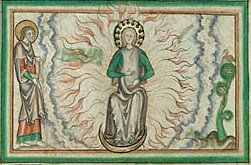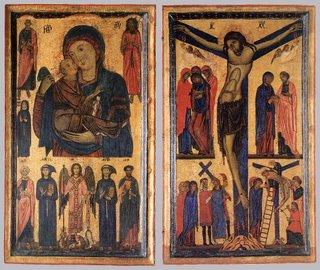Evangelium VitaeHis Holiness Pope John Paul IIEncyclical Letter, March 25, 1995
The Solemnity of the Annunciation of the Lord
"A great portent appeared in heaven, a woman clothed with the sun" (Rev 12:1): the motherhood of Mary and of the Church.
103. The mutual relationship between the mystery of the Church and Mary appears clearly in the "great portent" described in the Book of Revelation: "A great portent appeared in heaven, a woman clothed with the sun, with the moon under her feet, and on her head a crown of twelve stars" (12:1).
In this sign, the Church recognizes an image of her own mystery: present in history, she knows that she transcends history, inasmuch as she constitutes on earth the "seed and beginning" of the Kingdom of God. The Church sees this mystery fulfilled in complete and exemplary fashion in Mary. She is the woman of glory in whom God's plan could be carried out with supreme perfection.
 The "woman clothed with the sun" -- the Book of Revelation tells us -- "was with child" (12:2). The Church is fully aware that she bears within herself the Savior of the world, Christ the Lord. She is aware that she is called to offer Christ to the world, giving men and women new birth into God's own life. But the Church cannot forget that her mission was made possible by the motherhood of Mary
The "woman clothed with the sun" -- the Book of Revelation tells us -- "was with child" (12:2). The Church is fully aware that she bears within herself the Savior of the world, Christ the Lord. She is aware that she is called to offer Christ to the world, giving men and women new birth into God's own life. But the Church cannot forget that her mission was made possible by the motherhood of Mary, who conceived and bore the One who is "God from God," "true God from true God."
Mary is truly the Mother of God, the Theotokos, in whose motherhood the vocation to motherhood bestowed by God on every woman is raised to its highest level. Thus Mary becomes the model of the Church, called to be the "new Eve", the mother of believers, the mother of the "living."The Church's spiritual motherhood is only achieved -- the Church knows this too -- through the pangs and "the labor" of childbirth (cf. Rev 12:2), that is to say, in constant tension with the forces of evil which still roam the world and affect human hearts, offering resistance to Christ: "In him was life, and the life was the light of men. The light shines in the darkness, and the darkness has not overcome it" (Jn 1:4-5).
Like the Church, Mary too had to live her motherhood amid suffering: "This child is set ... for a sign that is spoken against -- and a sword will pierce through your own soul also -- that thoughts out of many hearts may be revealed" (Lk 2:34-35). The words which Simeon addresses to Mary at the very beginning of the Savior’s earthly life sum up and prefigure the rejection of Jesus, and with him of Mary, a rejection which will reach its culmination on Calvary. "Standing by the cross of Jesus" (Jn 19:25), Mary shares in the gift which the Son makes of himself: she offers Jesus, gives him over, and begets him to the end for our sake.
The "yes" spoken on the day of the Annunciation reaches full maturity on the day of the Cross, when the time comes for Mary to receive and beget as her children all those who become disciples, pouring out upon them the saving love of her Son: "When Jesus saw his mother, and the disciple whom he loved standing near, he said to his mother, ‘Woman, behold, your son!'" (Jn 19:26).
"And the dragon stood before the woman ... that he might devour her child when she brought it forth" (Rev 12:4): life menaced by the forces of evil.104. In the Book of Revelation, the "great portent" of the "woman" (12:1) is accompanied by "another portent which appeared in heaven": "a great red dragon" (Rev 12:3), which represents Satan, the personal power of evil, as well as all the powers of evil at work in history and opposing the Church's mission.
Here too Mary sheds light on the Community of Believers.
The hostility of the powers of evil is, in fact, an insidious opposition which, before affecting the disciples of Jesus, is directed against his mother. To save the life of her Son from those who fear him as a dangerous threat, Mary has to flee with Joseph and the Child into Egypt (cf. Mt 2:13-15).
 Mary thus helps the Church to realize that life is always at the centrr of a great struggle between good and evil, between light and darkness. The dragon wishes to devour "the child brought forth" (cf. Rev 12:4), a figure of Christ, whom Mary brought forth "in the fullness of time" (Gal 4:4) and whom the Church must unceasingly offer to people in every age
Mary thus helps the Church to realize that life is always at the centrr of a great struggle between good and evil, between light and darkness. The dragon wishes to devour "the child brought forth" (cf. Rev 12:4), a figure of Christ, whom Mary brought forth "in the fullness of time" (Gal 4:4) and whom the Church must unceasingly offer to people in every age. But in a way that child is also a figure of every person, every child, especially every helpless baby whose life is threatened, because -- as the Council reminds us -- "by his Incarnation the Son of God has united himself in some fashion with every person."
It is precisely in the "flesh" of every person that Christ continues to reveal himself and to enter into fellowship with us, so that rejection of human life, in whatever form that rejection takes, is really a rejection of Christ. This is the fascinating but also demanding truth which Christ reveals to us and which his Church continues untiringly to proclaim: "Whoever receives one such child in my name receives me" (Mt 18:5); "Truly, I say to you, as you did it to one of the least of these my brethren, you did it to me" (Mt 25:40).
"Death shall be no more" (Rev 21:4): the splendor of the Resurrection.105. The angel's Annunciation to Mary is framed by these reassuring words: "Do not be afraid, Mary" and "with God nothing will be impossible" (Lk 1:30, 37).
The whole of the Virgin Mother's life is in fact pervaded by the certainty that God is near to her and that he accompanies her with his providential care.
The same is true of the Church, which finds "a place prepared by God" (Rev 12:6) in the desert, the place of trial but also of the manifestation of God's love for his people (cf. Hos 2:16). Mary is a living word of comfort for the Church in her struggle against death. Showing us the Son, the Church assures us that in him the forces of death have already been defeated: "Death with life contended: combat strangely ended! Life's own Champion, slain, yet lives to reign."
The Lamb who was slain is alive, bearing the marks of his Passion in the splendor of the Resurrection. He alone is master of all the events of history: he opens its "seals" (cf. Rev 5:1-10) and proclaims, in time and beyond, the power of life over death. In the "new Jerusalem," that new world towards which human history is travelling, "death shall be no more, neither shall there be mourning nor crying nor pain any more, for the former things have passed away" (Rev 21:4).
And as we, the pilgrim people, the people of life and for life, make our way in confidence towards "a new heaven and a new earth" (Rev 21:1), we look to her who is for us "a sign of sure hope and solace."








 Roe v. Wade, 410 U.S. 113 (1973)
Roe v. Wade, 410 U.S. 113 (1973)

